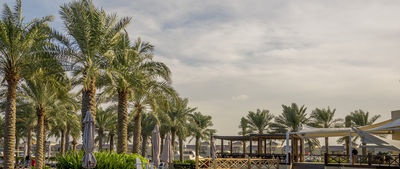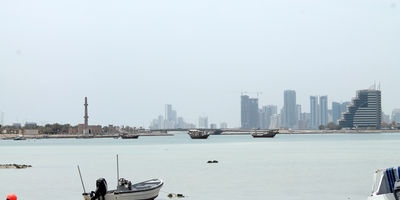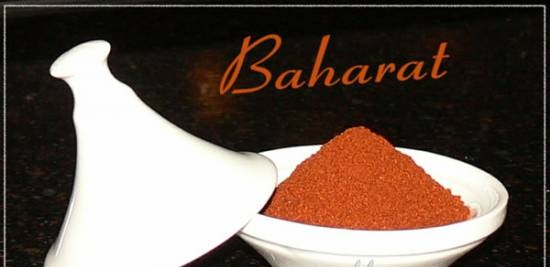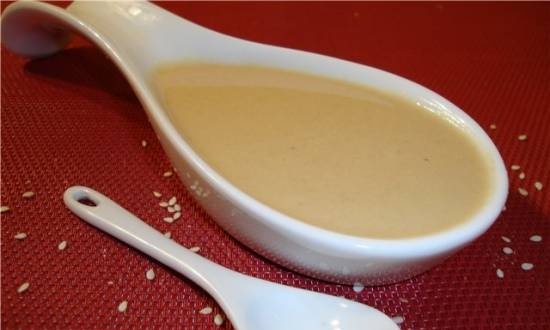|
 Bahrain is the only island Arab sheikhity located off the coast of the Arabian Peninsula in the Persian Gulf. It is commonly called the country of pearls and oil. But this definition is too sparse. Bahrain is the only island Arab sheikhity located off the coast of the Arabian Peninsula in the Persian Gulf. It is commonly called the country of pearls and oil. But this definition is too sparse.
Bahrain is an island archipelago with 25 islands and islets, but the largest of them are El Bahrain, El Muharraq, Sitra and Umm Nassan. It lies in the very center of Bahrain Bay, bounded on the west by the coast of Al-Khas, which is part of Saudi Arabia, and on the east by the Qatar Peninsula. The Bahrain archipelago is small: its area is only 553.8 square kilometers.
Most of the archipelago is occupied by the plain, and only in the center of the island of El Bahrain there are low hills, no more than 20 meters high, among which seven limestone peaks - Jebel Dukhan - soared up.
Sitra Island looks green because palm trees grow on its territory. But the island of Umm-Nassash, adjacent to El Bah Rhine from the west, is a real desert.
Many travelers who find themselves among its red-hot sands had to hear them sing. People have always been amazed how melodies suddenly appear in the desert and just as suddenly disappear. For several centuries they could not find a solution to such an extraordinary phenomenon. More recently, this riddle was attributed to hallucinations caused by a prolonged stay in the desert, striking a person with the monotony of its sands.
However, not everyone agreed with this explanation. People began to think about the solution to the singing desert and most often came to the conclusion that the melodies arise as a result of the influence of the wind on the sand dunes.
 Bahrain's climate is transitional from tropical to subtropical. It rains in winter, and summers are dry and dry. The post office throughout the year feels the sultry breath of the vast waterless deserts of the Arabian Peninsula: with temperatures in winter up to 25-30, and in summer - up to 50 degrees. On the island of Umm Nassan, the climate is semi-desert. In its central part, only occasionally there are oases where you can rest and hide from the unbearable heat. Bahrain's climate is transitional from tropical to subtropical. It rains in winter, and summers are dry and dry. The post office throughout the year feels the sultry breath of the vast waterless deserts of the Arabian Peninsula: with temperatures in winter up to 25-30, and in summer - up to 50 degrees. On the island of Umm Nassan, the climate is semi-desert. In its central part, only occasionally there are oases where you can rest and hide from the unbearable heat.
The Bahrain Archipelago is rich in oil and was one of the first places in the world to find such a valuable mineral. But most of its territory is barren. Only saxaul, trees with thorny branches and individual bunches of grass can grow on sandy soil. Only on the island of Sitra and in the vicinity of large cities such as Manama, there are many gardens and greenery, in which residential quarters are buried.
Bahraini people are engaged in gardening cultivating date palms, citrus fruits, pomegranates, figs, mango, grapes, almonds and other southern fruits. In addition, attention is paid to garden crops such as tomatoes, melons, pumpkin, onions, eggplant, sweet potatoes. Grain farming is of much lesser importance. Only in small areas is it sown corn, barley and wheat. Bahrain lacks its own grain and, like many other agricultural products, is constantly imported from other countries.
Bahrain has a lot of water that comes from springs or rises to the surface from artesian wells. The origin of the water sources has not yet been established and is still the subject of scientific controversy. Water often gushes at the bottom of the Persian Gulf, constantly freshening its waters along with the great rivers of Mesopotamia flowing into it. That is why the word "Bahrain" means "two seas", and the springs at the bottom of the bay gave rise to the expression: "Bahrain is a sea of springs."
Fresh water is collected in the sea the moment it flows to the bottom of the bay. But the locals also know another way to collect water. A bamboo tube is inserted into the spring so that one end of it rises somewhat above the sea surface. There is so much water in the Persian Gulf that pearl divers who are in the sea prefer to replenish their fresh water supplies from these sources, rather than waste time traveling on land.
The bulk of Bahrain's population lives on the islands of Bahrain, Al-Muharraq and Sitra. The majority of the inhabitants are Arabs. Others have their origins in the countries of the Near and Middle East, Africa and Southeast Asia. Several thousand Europeans and Americans also live there permanently.
The main inhabited areas are considered to be the combined cities of Manama and Muharrak, which are located on different islands, but are connected by a five-kilometer dam suitable for car traffic. The city of Manama is the capital of Bahrain. It is the most advertising city in the Gulf region.
 The abundance of water and greenery is the main feature of the Manama landscape. The water mirrors of the bay and the channel reflect the silhouettes of large buildings and bizarre weaving of tree crowns. The domes of mosques shine in the sun, the crowd echoes in the streets of the city, like a disturbed hive, the bazaar is noisy - an integral part of any city in the Arab East. The abundance of water and greenery is the main feature of the Manama landscape. The water mirrors of the bay and the channel reflect the silhouettes of large buildings and bizarre weaving of tree crowns. The domes of mosques shine in the sun, the crowd echoes in the streets of the city, like a disturbed hive, the bazaar is noisy - an integral part of any city in the Arab East.
In summer, over Manama, as always at this time of the year, there is a clear and high blue sky. At night, the city, stretching along the coast of the bay, glows with thousands of lights, as if approaching peacefully sparkling stars. And only the roar of jet aircraft engines often breaks the silence.
The city has preserved buildings erected many years ago in the traditional style of Arab architecture. The houses with high towers with openings for cooling all living quarters during the summer heat are especially peculiar. Such ingenious devices - the forerunners of modern refrigeration units - were noticed by the famous medieval traveler Marco Polo, who once visited the countries of the Middle East.
Poverty and poor neighborhoods with randomly scattered dilapidated houses coexist side by side with wealth and comfort. The main building materials in Bahrain are limestone and coral slabs raised from the bottom of the Persian Gulf. They are used to make walls of houses and fences around gardens. There is a widespread shortage of wood for construction.
On the outskirts of Manama, as on the entire coast of the island of Bahrain, scattered fishing huts and light houses of the poor, hastily constructed from the trunks of a palm tree. The coastal waters around the islands of the Bahrain Archipelago are abundant in fish. However, the shallows serve not only for fishing, but also for pearl extraction. Bahrain's pearl fishery is world famous. There was a time when more than 1000 boats with 20 000 pearl hunters went to sea. But now the number of boats has decreased to 300, and thousands of pearl divers, having lost all hope of getting out of the hopeless poverty in which they found themselves, went to work in the oil fields.
And today, the world's best pearls are still mined in the Persian Gulf. The pearl fishing usually starts from May 15 to September 15. There are traditions associated with pearl mining. Before going to sea, for example, the owner or captain of a fishing vessel kisses pearl seekers on the forehead, thus cementing mutual obligations.
 You can hardly find a harder and more exhausting job. Pearl divers do not wear a special suit. They only pinch their nostrils with special wooden clips when they dive to the bottom of the sea. Each of them has a dagger in a wooden sheath attached to its side with a special strap, which serves to protect against attacks by sharks and other sea predators. The duration of stay under water is no more than 45-50 seconds, and in exceptional cases - 60-70 and even 90 seconds. You can hardly find a harder and more exhausting job. Pearl divers do not wear a special suit. They only pinch their nostrils with special wooden clips when they dive to the bottom of the sea. Each of them has a dagger in a wooden sheath attached to its side with a special strap, which serves to protect against attacks by sharks and other sea predators. The duration of stay under water is no more than 45-50 seconds, and in exceptional cases - 60-70 and even 90 seconds.
Pearl fishing continues during the four hottest months, when there is complete calm. In order to stay under water longer, the catcher must constantly limit himself in food, therefore his daily diet consists of a small amount of rice and dates. Due to the lack of fresh water, catchers cannot wash away the salt water, which corrodes the skin and causes constant irritation. Their bodies are always covered with scabs, and their eyes are inflamed and festering. In addition, they often suffer from diseases such as scurvy and rheumatism; among them ear diseases and nosebleeds are considered common. And, finally, they are always in danger of being attacked by sharks, sawfish and other equally dangerous marine predators. The hard, exhausting work of pearl seekers, whose life is full of risks and accidents, leads to premature old age and death.
The best pearl bars are located north and east of the Bahrain Archipelago. Pearl seekers approach them in boats and anchor. Jumping from the boat, the catcher quickly plunges into the water to a depth of 10-20 meters, holding on to the cable, to which is attached a large stone - a sinker for immersion in the water. He holds on to the stone with one hand, while with the other he collects the shells into a small basket attached to his neck. Pearls can lie on the bottom of the sea, or they are attached to a shell. In the latter case, they are cheaper, because after separation from the shell, a trace remains, which somewhat spoils the shape of the pearl. The most valuable pearls are those that have a regular spherical shape, and then pear-shaped and oval. The color of pearls is usually white, pink or yellowish, and sometimes black, often with a silvery tint; size - from microscopic to the size of a pigeon's egg.
As soon as the air supply runs out, the pearl diver, having thrown the load, climbs onto the boat to take a short respite, and then descend to the bottom of the sea again. The caught shells are carefully examined, then the muscle of the oyster that closes the shells is carefully cut with a knife. Having removed the gelatinous mass of the mollusk, examine the edges of the shell, where the pearls are located. Some seekers occasionally manage to find a "red rose" - the most beautiful pearl in the world.
 Pearl divers continuously dive into the water for 6-8 hours a day, taking only short breaks of several minutes for short breaks. Pearl divers continuously dive into the water for 6-8 hours a day, taking only short breaks of several minutes for short breaks.
The time when the pearl fishing ends is the happiest for both the catcher and his family. The harvested pearls are usually sold to the buyer, who pays off after the sale of all the pearls caught. Most of the proceeds go into the pocket of the owner and captain of the ship, as well as the buyers who keep the pearl divers in constant bondage.
However, pearls are not the only wealth that Bahrain has. The island of Bahrain has rich reserves of oil refined at a local refinery, which is also connected to an underwater pipeline to pump oil from the Arabian Peninsula.
In the harbor, on the huge cisterns, the inscription "Bapko" is visible. It is an American company that has seized the wealth of Bahrain. Its property is not only oil, but also the port of Sitra - one of the largest oil harbors in the Persian Gulf region.
The city of Avali became the center of oil production. There are almost no oil rigs to be seen in its vicinity, but there are many invisible valves, half buried in the sand. Oil was discovered here in 1932, but the history of the island goes back centuries. Mounds rise around Avali. Scientists have established that their construction dates back to the period when a person owned only bronze weapons. Stone tools found in the mounds date back to 2000 BC. e. In addition, they contain samples of fragile Islamic glass from the 10th century. How these things from so different eras got here is still a mystery. There is also an opinion that Bahrain was once, apparently, a cemetery.This is indicated by some names: Manama - "Place of sleep", Avali - "High place", Muharrak - "Burial place" - all of them are somehow connected with the funeral ritual.
Written references to Bahrain date back to the 3rd millennium BC. e. Herodotus, Justin, Pliny and other great thinkers of antiquity wrote about his riches. Many of the information they reported later turned out to be confirmed by materials from archaeological excavations.
In the IV-VI centuries AD Bahrain came under the influence of Iran.
 It later became part of the Arab Caliphate and a vassal principality dependent on other, more powerful Arab states. In 1258, Bahrain managed to gain independence, but it was soon lost due to the conquest of the medieval state of Hormuz. In the 16th century, Bahrain was attacked by the Portuguese colonialists, who were expelled in the 17th century by the combined forces of the Iranians and the British. For almost 100 years, Bahrain once again remained under the yoke of Iran. But then foreign rule was overthrown - and Bahrain became free. However, this time the gained independence did not last long. Bahrain was soon conquered by neighboring Oman. It later became part of the Arab Caliphate and a vassal principality dependent on other, more powerful Arab states. In 1258, Bahrain managed to gain independence, but it was soon lost due to the conquest of the medieval state of Hormuz. In the 16th century, Bahrain was attacked by the Portuguese colonialists, who were expelled in the 17th century by the combined forces of the Iranians and the British. For almost 100 years, Bahrain once again remained under the yoke of Iran. But then foreign rule was overthrown - and Bahrain became free. However, this time the gained independence did not last long. Bahrain was soon conquered by neighboring Oman.
At the end of the 18th century, the Arab tribe Beni Utbah (Bani Utba) landed on the Bahrain archipelago, expelled from Kuwait. The Al-Khalifa dynasty established its rule over the islands, which continues to this day.
From the beginning of the 19th century, the countries of the Arabian Peninsula, one after another, began to fall under the influence of the British colonialists, who, by means of blackmail, shameless deception and intrigue, brought Bahrain under their control. At present, although Bahrain is formally considered an independent sheikh, in reality it is the possession of England, which turned the city of Manama into the "capital" of its "possessions" located in the Persian Gulf.
The sheikh and the local nobility, together with British advisers and American oil-producing monopolies, are mercilessly exploiting the natural resources and the people of Bahrain. Despite the fact that the country has a modern oil industry, it remains weak and backward. Foreign imperialists and local feudal lords, in order to maintain their rule, do not develop other branches of the national economy.
Until recently, it seemed that time in Bahrain had stopped. Now, if this phrase can be used, it is only in relation to the past. As for modern Bahrain, this country changes every year, and only the sky pale from the heat, as if tinted with bright paint, and clouds merging with the desert horizon - that's probably all that remains unchanged here.
J. Trufanov
Read now
All recipes
|
 Bahrain is the only island Arab sheikhity located off the coast of the Arabian Peninsula in the Persian Gulf. It is commonly called the country of pearls and oil. But this definition is too sparse.
Bahrain is the only island Arab sheikhity located off the coast of the Arabian Peninsula in the Persian Gulf. It is commonly called the country of pearls and oil. But this definition is too sparse. Bahrain's climate is transitional from tropical to subtropical. It rains in winter, and summers are dry and dry. The post office throughout the year feels the sultry breath of the vast waterless deserts of the Arabian Peninsula: with temperatures in winter up to 25-30, and in summer - up to 50 degrees. On the island of Umm Nassan, the climate is semi-desert. In its central part, only occasionally there are oases where you can rest and hide from the unbearable heat.
Bahrain's climate is transitional from tropical to subtropical. It rains in winter, and summers are dry and dry. The post office throughout the year feels the sultry breath of the vast waterless deserts of the Arabian Peninsula: with temperatures in winter up to 25-30, and in summer - up to 50 degrees. On the island of Umm Nassan, the climate is semi-desert. In its central part, only occasionally there are oases where you can rest and hide from the unbearable heat. The abundance of water and greenery is the main feature of the Manama landscape. The water mirrors of the bay and the channel reflect the silhouettes of large buildings and bizarre weaving of tree crowns. The domes of mosques shine in the sun, the crowd echoes in the streets of the city, like a disturbed hive, the bazaar is noisy - an integral part of any city in the Arab East.
The abundance of water and greenery is the main feature of the Manama landscape. The water mirrors of the bay and the channel reflect the silhouettes of large buildings and bizarre weaving of tree crowns. The domes of mosques shine in the sun, the crowd echoes in the streets of the city, like a disturbed hive, the bazaar is noisy - an integral part of any city in the Arab East. You can hardly find a harder and more exhausting job. Pearl divers do not wear a special suit. They only pinch their nostrils with special wooden clips when they dive to the bottom of the sea. Each of them has a dagger in a wooden sheath attached to its side with a special strap, which serves to protect against attacks by sharks and other sea predators. The duration of stay under water is no more than 45-50 seconds, and in exceptional cases - 60-70 and even 90 seconds.
You can hardly find a harder and more exhausting job. Pearl divers do not wear a special suit. They only pinch their nostrils with special wooden clips when they dive to the bottom of the sea. Each of them has a dagger in a wooden sheath attached to its side with a special strap, which serves to protect against attacks by sharks and other sea predators. The duration of stay under water is no more than 45-50 seconds, and in exceptional cases - 60-70 and even 90 seconds. Pearl divers continuously dive into the water for 6-8 hours a day, taking only short breaks of several minutes for short breaks.
Pearl divers continuously dive into the water for 6-8 hours a day, taking only short breaks of several minutes for short breaks. It later became part of the Arab Caliphate and a vassal principality dependent on other, more powerful Arab states. In 1258, Bahrain managed to gain independence, but it was soon lost due to the conquest of the medieval state of Hormuz. In the 16th century, Bahrain was attacked by the Portuguese colonialists, who were expelled in the 17th century by the combined forces of the Iranians and the British. For almost 100 years, Bahrain once again remained under the yoke of Iran. But then foreign rule was overthrown - and Bahrain became free. However, this time the gained independence did not last long. Bahrain was soon conquered by neighboring Oman.
It later became part of the Arab Caliphate and a vassal principality dependent on other, more powerful Arab states. In 1258, Bahrain managed to gain independence, but it was soon lost due to the conquest of the medieval state of Hormuz. In the 16th century, Bahrain was attacked by the Portuguese colonialists, who were expelled in the 17th century by the combined forces of the Iranians and the British. For almost 100 years, Bahrain once again remained under the yoke of Iran. But then foreign rule was overthrown - and Bahrain became free. However, this time the gained independence did not last long. Bahrain was soon conquered by neighboring Oman.







